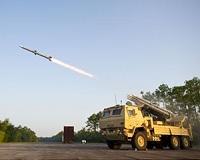| . |  |
. |
Tel Aviv, Israel (UPI) Dec 14, 2010 Maj. Gen. Gadi Eisenkot, commander of Israel's northern front, has dropped a bombshell by disclosing that the anti-missile systems the defense industry has developed are intended to protect the country's military installations, not its cities and civilian population. "The residents of Israel shouldn't be under the illusion that someone will open an umbrella over the heads" in the event of a massive missile and rocket attack by Israel's enemies, he declared in a speech Sunday at the University of Haifa. "The systems are designed to protect military bases, even if this means that citizens suffer discomfort during the days of battle." Eisenkot's uncompromising statement did nothing to ease a spate of dire warnings by political and military chiefs in recent weeks that Israel's cities, particularly Tel Aviv and its densely populated environs, will be major targets in any new conflict. In November, the outgoing head of Military Intelligence, Maj. Gen. Amos Yadlin, painted a stark and unvarnished picture of what the Israeli population can expect in the country's next war. "Tel Aviv will be a front line in the next conflict," he told Prime Minister Binyamin Netanyahu's Cabinet in his final briefing after five years as the military's intelligence director. A few days earlier he gave an equally bleak forecast to the Knesset's Foreign Affairs and Defense Committee, noting that "future wars will be much bigger, much wider and with many more casualties" than Israel's conflicts in Lebanon in 2006 and the Gaza Strip in the winter of 2008-09. The key factor here is that Iran, Syria, Hezbollah in Lebanon and Hamas in Gaza are expected to bombard Israel relentlessly with an unprecedented firestorm of missiles and rockets if hostilities break out once again. Israel got a taste of that in the 34-day 2006 war, when Hezbollah unleashed nearly 4,000 rockets into northern Israel, the heaviest bombardment Israelis have ever suffered. These weapons, mainly unguided rockets, killed around 50 people. Next time, Israel is likely to be hammered with far greater broadsides using missiles with far greater range, accuracy and destructive power than ever before. Fatality forecasts run into thousands. The Israeli military estimates Hezbollah has at least 42,000 rockets and missiles, hundreds of which can hit anywhere in Israel. Syria is reported to be receiving advanced missiles from Iran and to be upgrading the capabilities of its existing arsenal. Iran reportedly has more than 100 Shehab-3b ballistic missiles deployed and to be developing a more powerful weapon, the Sejjil-2, capable of hitting Israeli targets. After 2006, when Israel's vulnerabilities to missile attack were exposed for all to see, the country's defense industry raced to develop defense systems to counter this new threat. The Arrow system, capable of intercepting Iranian ballistic missiles at high altitude and at long range, was already in operation. Arrow, developed by state-owned Israel Aerospace Industries and the Boeing Co., was largely funded by the Pentagon. But this system is useless against shorter range weapons. Enter a system called Iron Dome, designed to counter the short-range rockets like those used by Hezbollah and Hamas, and another, called David's Sling to defend against medium-range missiles. Two batteries of Iron Dome, built by Rafael Advanced Defense Systems, are ready. But military planners say at least 20 are needed if the system is to be anywhere near effective. Rafael is still developing David's Sling and the first live-fire test is scheduled for the next few months. The first hint Israelis got that Iron Dome, which critics say will never be able to counter heavy rocket fire, won't be deployed to protect their cities came Nov. 9. The Jerusalem Post daily reported that the system would be stored at an airbase and would be deployed only in cases of extreme rocket fire. "Budget limitations will obviously prevent the procurement of tens of thousands of defensive missiles," Reuven Pedatzur, a strong critic of the air-defense strategy, wrote in the Haaretz daily Dec. 2. "In the best case, defense officials talk about hundreds of such missiles. Thus even if these systems prove effective (and there is no guarantee of that), they can provide as defense against only a small proportion of the rockets and missiles that would be fired at Israel during a war."
Share This Article With Planet Earth
Related Links Learn about missile defense at SpaceWar.com All about missiles at SpaceWar.com
 Raytheon's SLAMRAAM Completes Second Test Firing from New Platform
Raytheon's SLAMRAAM Completes Second Test Firing from New PlatformTewksbury MA (SPX) Dec 14, 2010 Raytheon's SLAMRAAM (Surface Launched Advanced Medium Range Air-to-Air Missile) system successfully participated in a second ballistic test vehicle firing at Eglin Air Force Base, Fla. This is the second test firing of AMRAAM missiles from the new Family of Medium Tactical Vehicle (FMTV) platform. "Completion of this second test firing in such a short span of time demonstrates the maturity ... read more |
|
| The content herein, unless otherwise known to be public domain, are Copyright 1995-2010 - SpaceDaily. AFP and UPI Wire Stories are copyright Agence France-Presse and United Press International. ESA Portal Reports are copyright European Space Agency. All NASA sourced material is public domain. Additional copyrights may apply in whole or part to other bona fide parties. Advertising does not imply endorsement,agreement or approval of any opinions, statements or information provided by SpaceDaily on any Web page published or hosted by SpaceDaily. Privacy Statement |